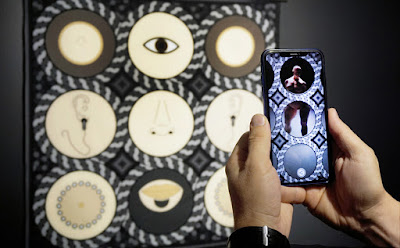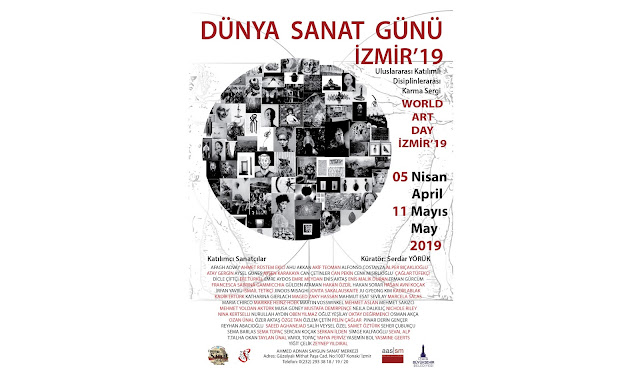Saco Bienali "Boşluğu Mesken Tutmak"

Inhabiting the Void - Augmented Reality Art
Ahmet Rüstem Ekici ve Hakan Sorar'ın, küratör Fırat Arapoğlu davetiyle Şili'deki Saco Bienali'nde sergilenen "Inhabiting the Void" (Boşluğu Mesken Tutmak) başlıklı yerleştirmesi, mimari bir formu temel alarak çok katmanlı bir sorgulama alanı yaratır. Eserin merkezinde, tiyatro mimarisinin temel bir unsuru olan proscenium (sahne çerçevesi) yer alır. Mimaride proscenium, seyirci ile sahne arasındaki fiziksel ve psikolojik sınırı çizen, kurgu ile gerçekliği birbirinden ayıran bir çerçevedir. Ekici ve Sorar, bu tarihsel formu yeniden yorumlayarak, onu bir ayrım duvarı olmaktan çıkarıp, görünen ile görünmeyen, coğrafyalar ve zamanlar arasında bir geçiş kapısı olarak yeniden tanımlar.
Yapıtın fiziksel temelini oluşturan tekstil yüzey, kıtalararası bir diyaloğun ve teknolojik bir sentezin somut bir çıktısıdır. Sanatçılar, bienal küratörü Dagmara Wyskiel'in Antofagasta'dan ilettiği yerel doku fotoğraflarını, bir yapay zeka modelinde bir araya getirmiştir. Bu süreç, sadece estetik bir arayış değil, aynı zamanda coğrafyanın kültürel ve tarihsel belleğini tek bir yüzeyde kodlama girişimidir. Kumaş üzerine işlenen tuğla formundaki delikler, sert ve kalıcı bir mimari unsuru, akışkan ve geçici bir malzeme olan tekstil ile sunarak bir optik yanılsama yaratır. Bu durum, malzemenin ve formun algısal sınırlarını araştıran, eserin kendi içinde barındırdığı zıtlıkların ilk işaretidir.
Eserin en kritik katmanı ise, bu fiziksel yapının merkezindeki boşluğun artırılmış gerçeklik (AR) teknolojisiyle etkinleştirilmesiyle ortaya çıkar. Artırılmış gerçeklik, akıllı telefon veya tablet gibi bir cihaz aracılığıyla fiziksel dünyanın üzerine dijital bilgi katmanları (görsel, ses, metin) ekleyerek gerçeklik algısını zenginleştiren bir teknolojidir. "Inhabiting the Void"de AR, bir görsel efekt aracı olmanın ötesinde, eserin kavramsal çekirdeğini oluşturan bir mekanizma olarak işlev görür. İzleyici, mobil cihazını merkezdeki boşluğa yönelttiğinde, fiziksel düzlemde görünmeyen dijital bir sahneyi aktive eder. Bu artırılmış gerçeklik uygulaması Artivive App ile gerçekleşir.
Dijital katman, eserin sergilendiği coğrafyanın en acil ekolojik sorunlarından birine, Atacama Çölü'ndeki küresel tekstil endüstrisinin yarattığı "moda çöplüğüne" odaklanan eleştirel bir içerik sunar. Modanın tüketim döngüleri, tekstilin kutsallaştırılması ve ardından değersizleşmesi üzerine kurgulanan bu dijital performans, eserin estetik yüzeyi ile politik ve rahatsız edici bir gerçeklik arasında bir gerilim yaratır. Böylece AR, görünmeyeni görünür kılarken, izleyiciyi sadece bir sanat eserine bakmaktan çıkarıp, küresel bir sorunun tanığı haline getirir.
Sonuç olarak, "Inhabiting the Void", izleyiciyi edilgen gözlemci konumundan, kendi eylemiyle dijital katmanı "var eden" ve anlamı yeniden inşa eden aktif bir katılımcıya dönüştürür. Eser, arkeolojik bellek ile dijital geleceği, coğrafi uzaklık ile ekolojik yakınlığı ve estetik form ile politik eleştiriyi tek bir deneyimde birleştirir. Sanatçılar, tarihsel bir mimari formu günümüz teknolojileriyle yeniden yorumlayarak, izleyiciyi algının, gerçekliğin ve bir sanat eserinin barındırabileceği anlamların sınırları üzerine düşünmeye davet eder. Bu yolla eser, boşluğu bir sonlanma noktası olarak değil, içinde yeni anlatıların ve eleştirel diyalogların kurulabileceği, yaşayan, aktif bir alan olarak yeniden tanımlar.
------------------------------------------------------------------------------------------------------------------
“Inhabiting the Void”: Una Traducción al Español
La instalación titulada "Inhabiting the Void" (Habitar el Vacío), de Ahmet Rüstem Ekici y Hakan Sorar, presentada en la Bienal Saco en Chile por invitación del curador Fırat Arapoğlu, crea un espacio de cuestionamiento en múltiples capas, basado en una forma arquitectónica. En el centro de la obra se encuentra el proscenio, un elemento fundamental de la arquitectura teatral. En arquitectura, el proscenio es el marco que traza el límite físico y psicológico entre el público y el escenario, separando la ficción de la realidad. Ekici y Sorar reinterpretan esta forma histórica, transformándola de un muro de separación a un portal de transición entre lo visible y lo invisible, entre geografías y tiempos.
La superficie textil que constituye la base física de la obra es el resultado tangible de un diálogo intercontinental y una síntesis tecnológica. Los artistas combinaron fotografías de texturas locales de Antofagasta, enviadas por la curadora de la bienal Dagmara Wyskiel, en un modelo de inteligencia artificial. Este proceso no es solo una búsqueda estética, sino también un intento de codificar la memoria cultural e histórica de la geografía en una única superficie. Los orificios en forma de ladrillo en la tela crean una ilusión óptica al presentar un elemento arquitectónico duro y permanente con un material fluido y temporal como el textil. Esta condición es el primer indicio de las contradicciones que la obra alberga en su interior.
La capa más crítica de la obra emerge con la activación del vacío central de esta estructura física mediante la tecnología de realidad aumentada (RA). La realidad aumentada es una tecnología que enriquece la percepción de la realidad superponiendo capas de información digital (visuales, sonido, texto) sobre el mundo físico a través de un dispositivo como un teléfono inteligente o una tableta. En "Inhabiting the Void", la RA funciona como un mecanismo que constituye el núcleo conceptual de la obra, más allá de ser una herramienta de efectos visuales. Cuando el espectador dirige su dispositivo móvil hacia el vacío central, activa una escena digital invisible en el plano físico. Esta aplicación de realidad aumentada se realiza con la Artivive App.
La capa digital presenta un contenido crítico que se centra en uno de los problemas ecológicos más urgentes de la geografía donde se exhibe la obra: el "vertedero de moda" creado por la industria textil mundial en el Desierto de Atacama. Esta performance digital, construida sobre los ciclos de consumo de la moda, la sacralización y posterior devaluación de los textiles, crea una tensión entre la superficie estética de la obra y una realidad política e incómoda. De esta manera, al hacer visible lo invisible, la RA convierte al espectador de un mero observador de una obra de arte en testigo de un problema global.
En conclusión, "Inhabiting the Void" transforma al espectador de un observador pasivo a un participante activo que "da existencia" a la capa digital con su propia acción y reconstruye el significado. La obra combina la memoria arqueológica con el futuro digital, la distancia geográfica con la proximidad ecológica, y la forma estética con la crítica política en una única experiencia. Los artistas, al reinterpretar una forma arquitectónica histórica con las tecnologías actuales, invitan al espectador a reflexionar sobre los límites de la percepción, la realidad y los significados que una obra de arte puede albergar. De este modo, la obra redefine el vacío no como un punto final, sino como un espacio activo y vivo donde se pueden establecer nuevas narrativas y diálogos críticos.
-----------------------------------------------------------------------------------------------------------------
“Inhabiting the Void”: An English Translation
The installation titled "Inhabiting the Void" by Ahmet Rüstem Ekici and Hakan Sorar, exhibited at the Saco Biennial in Chile at the invitation of curator Fırat Arapoğlu, creates a multi-layered field of inquiry based on an architectural form. At the center of the work is the proscenium, a fundamental element of theater architecture. In architecture, the proscenium is the frame that draws the physical and psychological boundary between the audience and the stage, separating fiction from reality. Ekici and Sorar reinterpret this historical form, transforming it from a wall of separation into a gateway between the visible and the invisible, between geographies and times.
The textile surface that constitutes the physical foundation of the work is the tangible output of an intercontinental dialogue and a technological synthesis. The artists combined local texture photographs from Antofagasta, provided by the biennial's curator Dagmara Wyskiel, in an artificial intelligence model. This process is not just an aesthetic pursuit but also an attempt to encode the cultural and historical memory of the geography onto a single surface. The brick-shaped holes in the fabric create an optical illusion by presenting a hard and permanent architectural element with a fluid and temporary material like textile. This situation is the first indication of the contradictions the work holds within itself.
The most critical layer of the work emerges with the activation of the central void of this physical structure through augmented reality (AR) technology. Augmented reality is a technology that enriches the perception of reality by overlaying digital layers of information (visuals, sound, text) onto the physical world via a device like a smartphone or tablet. In "Inhabiting the Void," AR functions as a mechanism that constitutes the conceptual core of the work, going beyond being a visual effects tool. When the viewer directs their mobile device to the central void, they activate a digital scene that is invisible on the physical plane. This augmented reality application is realized with the Artivive App.
The digital layer presents critical content that focuses on one of the most urgent ecological problems of the geography where the work is exhibited: the "fashion junkyard" created by the global textile industry in the Atacama Desert. This digital performance, constructed upon the consumption cycles of fashion, the sacralization and subsequent devaluation of textiles, creates a tension between the aesthetic surface of the work and a political and unsettling reality. Thus, by making the invisible visible, AR turns the viewer from a mere observer of an artwork into a witness of a global problem.
In conclusion, "Inhabiting the Void" transforms the viewer from a passive observer into an active participant who "brings into being" the digital layer through their own action and reconstructs the meaning. The work combines archaeological memory with the digital future, geographical distance with ecological proximity, and aesthetic form with political critique in a single experience. By reinterpreting a historical architectural form with contemporary technologies, the artists invite the viewer to reflect on the limits of perception, reality, and the meanings an artwork can contain. In this way, the work redefines the void not as a point of termination, but as a living, active space where new narratives and critical dialogues can be established.


.jpg)







Yorumlar
Yorum Gönder